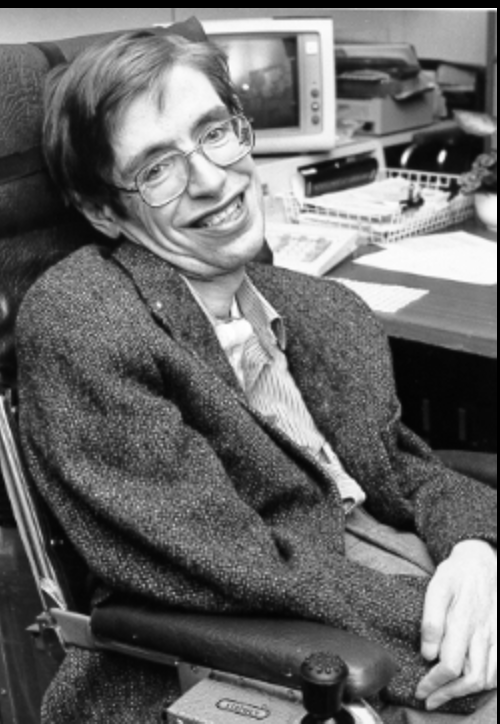
Stephen Hawking was born on January 8, 1942 in Oxford, England during the bombing horrors of World War II. In 1950, when Stephen’s father was appointed head of parasitology at the National Institute for Medical Research, the family moved to St. Albans where Stephen attended elementary school. In March 1959, he took the entrance examinations to Oxford and won a scholarship for enrolment in the natural sciences. Three years later, at age 20, he graduated with what was called a “first-class” degree, and he embarked on graduate work in general relativity and cosmology at Cambridge.
During his first year at Cambridge, Stephen noticed an instability in his physical coordination, and in early 1963 he was diagnosed with amyotrophic lateral sclerosis (ALS), commonly known as Lou Gehrig’s disease. The doctors forecast that he would not survive long enough to complete his doctoral studies. On receiving this horrific death sentence, Stephen descended into a deep depression, anticipating the impending debilitation and recognizing the futility of long-term goals. However, in the months that followed, encouragement from his thesis supervisor, Dennis Sciama, helped rekindle Hawking’s interest in pursuing research, and in 1966 he completed his doctorate in defiance of the dismal prognosis. His dissertation Properties of Expanding Universes, was followed by an essay Singularities and the Geometry of Space–Time that won the prestigious Adams Prize.
Between 1966 and 1973, Hawking continued his research on black holes and in 1970 he combined quantum theory with general relativity and deduced that black holes can emit radiation, (known today as “Hawking radiation”), overturning the consensus belief that energy in any form cannot escape black holes. In 1971, he deduced that shortly after the “Big Bang” explosion, masses the size of a proton would weigh 100,000 tons or more under the huge gravitational pressure. Later, he proposed that time and space are finite, but have no boundary or edge. This would eliminate singularities and imply that the laws of physics would apply universally following the Big Bang.
In 1973, Stephen Hawking co-authored with mathematician George Ellis, a book on general relativity titled, The Large Scale Structure of Space-Time. Through the 1970s, Hawking continued to work on black holes, quantum gravity, and quantum mechanics. His research gained wide acclaim and in 1979, he was appointed Lucasian Professor of Mathematics at Cambridge –the chair held by Sir Isaac Newton 3 centuries earlier.
In 1982, Hawking began work on a book to be titled, A Brief History of Time, that was to be a discussion of cosmology for the educated layman. By 1984, he had completed the first draft, but during the summer of 1985 he was hit with a death-threatening case of pneumonia requiring an immediate tracheotomy. It cost him his voice, so subsequent drafts of the book had to be dictated through a voice simulator. When A Brief History of Time was finally published in 1988, it was a blockbusting best-seller, breaking dozens of previous records for best-selling books. However, it has been conjectured that only a small percentage of the readers truly understood it. It seems that some ideas are too complex to be expressed in anything but mathematical language. Hawking had wanted to include several equations in the book, but lamented in the acknowledgments:
Someone told me that each equation I included in the book would halve the sales. I therefore resolved not to have any equations at all. In the end, however, I did put in one equation, Einstein’s famous equation E = mc2. I hope this will not scare off half of my potential readers. [Imagine how many books he’d have sold if he had left out that equation!]
Observing that the equations of physics are symmetric with respect to time, Hawking asked whether it is possible to travel backwards in time. Although every spatial motion can be reversed, physicists don’t know whether time can be reversed. However, the grandfather paradox argues that if a person traveled back in time, he could kill his grandfather before his father was conceived, thereby preventing his own existence. He also argued that if time travel were possible, we would see people from the future who had come back to visit. However, Hawking later suggested that time travel might be possible only in a specially warped region of space-time, but this will not enable reverse time travel until a future time. All we know for sure is that the time dilemma will not be resolved for a long time.
Stephen Hawking finally succumbed to ALS on March 14, 2018, having survived more than 50 years beyond the doctor’s prognosis. Throughout his life, he received a multitude of honours and was regarded by many as one of the geniuses of the 20th century. His remarkable achievements in the face of great adversity shine a bright light on his intellectual intensity and remarkable courage. In his 2018 posthumous publication, Brief Answers to the Big Questions, Hawking warned:
Aggression, …, has had definite survival advantage up to the present time. But now it could destroy the entire human race and much of the rest of life on Earth. A nuclear war is still the most immediate danger, but there are others, such as the release of a genetically engineered virus.
Stephen Hawking made this observation before the Covid virus was on the horizon and before Putin attacked Ukraine. His vision was far reaching.
